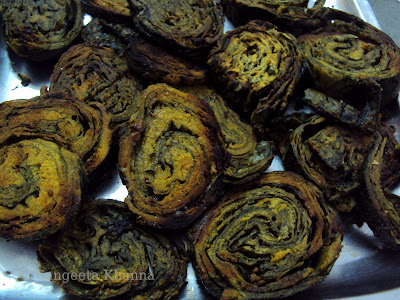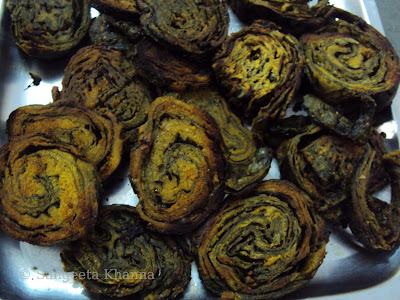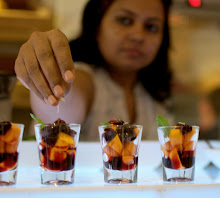The recipe of girmachh, rickwachh or patoda used to be the test of the new bride in some families I am told. However misogynist it sounds but I agree the recipe and procedure of making this patoda or rickwachh needs deft hands and some practice too. It is definitely a test of a good cook, man or woman. Luckily in my family all of us can make it regardless of gender. The dear husband is not a cook but a great helper when one is set out to make elaborate meals.
To find the recipe of rickwachh please scroll down if you are in a hurry. Else you might find the little stories of of our food interesting when you read from beginning.
I was in Banaras for two weeks and had a good time there. Roaming around the ghaats early in the morning, going for boating and watching the serene sunrise to illuminate our soul. Literally.
The early morning ghaat visit has become a ritual for us whenever we are in the city. It strangely feels like 'home' even though we have spent very little time on ghaats ever. It is something to do with the way these areas have not changed in the last 3 decades since we are witnessing.
Those from Banaras know that when we go to Dashashwamedh ghaat or Dr. Rajendra Prasad ghaat to watch sunrise we can take a bylane to reach a great fish market and a subzi market and this subzi market is no usual subzi market. There you get all those unusual vegetables and greens which you normally don't get to see in the city. Stems, roots and leaves of various shapes and sizes and may more things you wont even recognize and the subziwala will tell you the names and how to cook them.
That is where I found the leaves of colocasia/arbi ka patta on of the days we were on our holy walk.
We love the patoda made with it and never find these leaves in Delhi. I bought a few bunches of arbi ka patta from an old lady sitting on the corner where there are a few stoneware shops and a small mandir. The lady had at least 10 varieties of leaves and I even bought Bramhi from her and planted some of the stems in my dad's garden.
My dad has turned an avid gardener after retirement apart from doing some social service.
After planting the stem cutting of Bramhi and a few more herb plants I brought from this market, I made the patoda myself as the cook was doing other things, it was my brother's wedding and the whole family was around.
Since the kitchen was occupied by the cook I just spread out everything on living room floor and started layering and wrapping while a few young hands clicked a few pictures of the process on my request, my hands were messy with the besan paste :)
The pictures may not be very aesthetic and properly angled but you'd get a fair idea of the detailed process, it is not a difficult recipe but you need to have some patience and a little practice to roll thee leaves up tightly. For me it is always a pleasure to cook something which delights everybody in the family............
ingredients....
(to make 4 huge rolls, each roll sliced up to yield about ten patode)
colocasia leaves 40 nos.
besan (chickpea flour) 500 g
ginger garlic paste 2 tbsp
green chilly paste 1 tbsp
red chilly powder 1 tsp or more
cumin powder 1 tbsp
turmeric powder 1tbsp
amchoor powder 1 tbsp (more if using off the shelf kind)
salt to taste
to proceed...
Remove the stalks from the colocacia leaves and carefully remove the midrib from the dorsal side of the leaf, taking care not to tear the leaf.
Make a paste from the remaining ingredients, adding enough water to make a sticky paste, it should not be runny. The leaves have to be stuck together with the help of this paste and rolled up....
Spread a leaf dorsal side up (the side with prominent veins) on the back side of a thali or parat (a wide plate or even your kitchen platform), smear the paste over it generously and stick another leaf on it, keep smearing the paste and layering the leaves till 8-10 leaves are piled up.
It is better to align the pointed sides of the leaves in opposite direction for each layer, this way it makes a smooth n tight roll.......
Now fold an inch from both the sides of this layered up arrangement making a rectangular shape ...
And roll up tightly starting from far side towards yourself, tucking in the folded portions at the ends of the roll.......
Repeat to make more rolls till all the leaves are used......
Now place a suitably sized round wire rack in a wide kadhai or a pan and place all the rolls onto the rack, pour 2 cups of water into the pan (the water level should not touch the rolls), cover and steam the rolls till a tooth pick comes out clean. Any type of steamer can be used for this purpose and they can even be microwaved.
Let it cool and then keep the rolls in the fridge.
colocasia leaves may irritate or itch the inner lining of mouth because of oxalic acid crystals found in it , so it is better to let the rolls rest overnight into the fridge .
The next day they get firm enough to be neatly cut into slices. Shallow fry in mustard oil and enjoy the crisp spirals of yummy patode ........
This a traditional recipe of eastern UP, a delicacy, some people like it deep fried but we always stick to shallow fried version because even my mom used to make it this way. The spirals loosen up if you deep fry them and the patode become bigger in size, definitely more crispy but the oil it drinks up while deep frying gives me a heart attack. The rolls keep well in the fridge for a week and can be frozen for a couple of months.
Great as a tea time snack but it is mostly served as a side dish with daal-chawal-subzi-raita lunch. It was a wonderful experience making it because all my family members were there to savor them.
Tt was really great fun right from buying the leaves, preparing the rolls, taking pictures and eating them.
The name is patode but the specific eastern UP name is girmachh, the Gujarati version which is different in taste (just steamed sliced n served garnished with grated coconut) is called patra and that is great too. Actually the freshly steamed rolls can be sliced up while still warm and I like them just as it is with some green chutney and some imli paani. Sour toppings are good to have with it as the itching caused by colocasia leaves is neutralized this way.......
Lovely spirals. Delicious, crunchy, hot and sour. These spirals can be curried in masala gravy or a mustard gravy . Usually the leftovers are curried the next day.
You wouldn't ever want to waste such a delicately made dish, curried patode is great with plain boiled rice. You have to eat it to believe it.
I would love to know if it is made in your home, in what way do you make it if you do ............



























These look so tasty and delicious.Very delectable.
ReplyDeleteThanks darling........for being so quick.
ReplyDeleteThe patode or patras look great, Making Patode is hard work as the leaves need to be prepared and washed just perfectly. The patode looks very similar to the patras we make. The only difference is that we add tamarind to the paste.
ReplyDeleteLovely tasty patra ! I make quite often as they are my daughters faviourte..I've posted this on my blog too...
ReplyDeleteThanks Mina........yes it is hard work but i enjoyed doing it....
ReplyDeleteI love cooking good food for my family and it's always a pleasure to see happy faces on the dining table..
i love the Gujarati version too.
I'd love to see your version of this dish n will be searching it on you blog...tomorrow , now it's too late n i am sleepy...:)
ReplyDeleteIve never been lucky enough to find colacasia leaves around here. I love pathra and yours looks perfect..am craving 4 some now ..
ReplyDeleteSangeeta, you made these with 40 leaves? Wow! I am impressed! That must have taken a lot of time and patience. But I can see it was worth it. My grandma used to grow this in her backyard, next to the water tank and growing up we used to eat it all the time. Now, not many people, including me, have the patience for this.
ReplyDeleteIt is good to see you back to blogging and I hope you had a good time at your brother's wedding.
The peetha you mentioned, is it sweet and made from white pumpkin? That is the one I know. :)
Thanks Aipi and Jaya.....i know many people have tasted this dish but it is such a rare thing now , we don't get the leaves very often.
ReplyDeleteJaya.... the peetha i am talking about is a savory dish . A type of peetha bengalis make is sweet too , stuffed with jaggery n coconut , much like a maharashtrian steamed modak ...the one i am talking about is a spicy dal mixture stuffed in calzone like shapes n steamed.......i am coming up with that soon.
My favorite pathrodes..... I love them, mom goes to an extent of seasoning them all at the end..... Yum!!!!! :)
ReplyDeleteAsh...
(http://asha-oceanichope.blogspot.com/)
Dear Sangeeta
ReplyDeleteI love this dish. My daughter brings it from Mumbai whenever she comes. Now that I have your recipe , will try
have a nice day
Wow.. this is really a tasty dish..My hubby being a great fan of pathrodes would love this for sure :)Must try this recipe.thanks for sharing.
ReplyDeletePatras look mouthwatering. Loved the clicks as well.
ReplyDeleteDeepa
Hamaree Rasoi
I sure am glad that you had a pleasurable time with your family :)
ReplyDeleteThis patoda looks great!! I had heard that Arvi leaves are used to make pakodas but I have never had this dish.this is inspiring me to try this out immediately!! will be looking forward to your third eastern UP recipie :)
i have been meaning to try patra for such a long time! bookmarking this right now.
ReplyDeleteThat is such a great pic and lovely step by step pics :)
ReplyDeleteDear Sangeeta,
ReplyDeleteWelcome bk....n hw good it is to start wit the delicious patra. I learnt tis fm my MIL, the gujarati version, but surprisingly she adds de same spices but wit a lil buttermilk or tamarind n gur chutney to de batter. They r used to remove ny uncomfortable irritation of de leaves....N as u rightly said the leftovers r used in Undhiyo..a mixed seasonal vegetable dish.
Sadly I cud not find any colacassia leaves here in Mel, so hv planted an arbi root recently n desperatley waiting it to bloom.
Also waiting fr ur other snack peetha....
never tried this at home thnks for the lovely pictorial
ReplyDeleteLove the patra. We call it pathrado in Konkani and it is a very famous Manglorean dish. I have been following your blog for quite some time now and adore your posts. I have added it to my blog list:
ReplyDeletehttp://myculinaryexplorations.blogspot.com/
Thank you for posting this recipe; loved reading it. Our friends from Benaras make it the same way for curries; Particularly the tip: keeping the patode overnight and then shallow frying it.
ReplyDeletedelicious.. i make this often, it's very popular in Gujarat..in fact, was thinking of posting it sometime
ReplyDeletethats a delicious snack .once i bought the frozen patra . really good one.. now got the recipe.. thats really good one
ReplyDeleteBeing from Banaras I was curious to know what all are you going to write...eagarly waiting for Fara (use typical name ...Gointha! :-))post, i will be happy if it includes the one using rice flour for outer cover..
ReplyDeleteWao..U r doing a great job.
ReplyDeleteThanks a lot.
Thanks everybody for the sweet words.
ReplyDeletei am learning more about the similar regional dishes , never knew about the mangalorian pathrode and now when i search the web it's great to learn.
@ anonymous .... yes i am planning to make the fara ASAP.
hi sangeeta.. am a manglorean as well.. and my mum makies this back home... she adds ground masala to this without frying, and I guess what she makes does not have besan.. but it has rice in it.. if am not wrong..
ReplyDeleteThank u for ths delicious receipe
ReplyDeleteWow i just love these patoda ka pakoda ..u have a impressive blog..glad to follow u
ReplyDeletehttp://varietyisthespiceofyourlife.blogspot.com/
It was good reading this recepi. I have made it a number of times and my girls as well as husband love it. Your version is just the same as mine.
ReplyDeleteI am a resident of Delhi so I wish to tell you that we get the leaves easily in rainy season from July till September. If the sabziwala does not bring it I especially order it. I may have to pay a little more but he gets it for me and it is worth it when everyone loves the dish.I have tried making this with other big leaves but the taste is not the same.
Thank you Nalini ji for the inputs. We hav started getting the arbi leaves in Delhi now, the subzi wala in our weekly subzi market brings them. It wasn't easily available a decade ago.
DeleteIf you mix some rice flour with the besan then it becomes crunchy after frying.
ReplyDeleteYes that is the way to make it crisp. I do that sometimes. Thank you so much.
DeleteEvery place has a famous delicacy which it boasts about. One such dish is Patrode. Patrode is made of Arabi leaves is one of the delicious snack famous in Himachal Pradesh, http://www.omilights.com/recipe-to-make-himachali-arabi-patrode-or-pathrode/
ReplyDelete